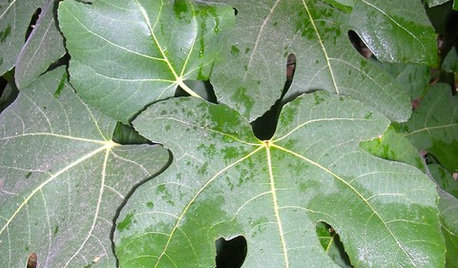I didn't write the following story. I was born in the US 50 years ago. But all my grandparents and a few great-grandparents came from Calabria 50 years before that. None of them brought a fig with them. Or at least one that survived in their new home in Pennsylvania's anthracite coal region. They had vegetable gardens and fruit and chestnut trees, but none of them ever grew figs. Still, this story explains why I grow them. And maybe someday my grandkids or a neighbor or a caregiver will remember me in this same way too.
Enjoy
Jim
Figs
by
Joseph E. Scalia
Sonovgod@aol.com
I remember the old woman stooped over in her garden, poking at the black dirt with the little shovel she always let me play with when she was finished working. I remember the autumn ritual of the glass bottles. How carefully she trimmed back the rosebushes until they were barely twigs, and then she sealed them in winter coffins of milk bottles and jars, their mouths pressed into the soil.
"It keeps them warm," she said gently in the Brooklyn dialect Italian that I spoke and understood so well when I was a child of five. "Things that are alive need warmth. And they need love."
She loved the little backyard plot that had once, long before I was born, been an arbor and a dense tangle of grape vines. She planned out her garden as carefully and deliberately as she had planned her own life. There were some tomatoes in the corner, little red plums that were cooked and bottled to become our sauce for the winter.
She planted a few sprigs of mint and some sweet basil. And then there were the flowers. She had some early blooming crocus, a section of lilies-of-the-valley at the lower end of the garden closest to the house, azaleas and tulips, and of course, the roses. They were her specialty, large blooming clusters of white, red, yellow and pink.
Throughout the summer she would cut bunches of her roses and send bouquets around the neighborhood. They were for people like the sick old Mrs. Mazzaferri, a long-time friend whose legs were so swollen and ulcerated that she never left her bed. And there were always flowers for the widow Cogan down the block, who had lost her husband in the war.
Although everything that grew in the garden received her attention, I remember she had a favorite that was even more special than the roses. It was the fig tree. It stood, short and squat, at the furthest extreme of the plot, sheltered by the low stone wall that marked the boundary of our property. She had carried it with her on the boat from her little town of Avellino near Naples, when she was a young woman. It was one of the stories she often told me, of those days before my mother was born, when my grandfather came to America to make a new life; and how, later, she had followed with the two babies, my uncles Joe and Jerry, who were born in Italy.
"And my mother, Nona? Tell me about my mother," was my inevitable response.
"Ah, in those days after I first came to America, I was so young, and your mother was just a little baby, smaller even than you are." Her soft brown eyes misted with the memories.
It was in the early spring, following her instinct, that we went out together and spent the day together in the garden. We'd pull away the black leaves she had allowed to collect around the plants from the previous fall.
"They keep the ground soft and warm," she explained. And as she turned over the dirt, I collected the worms. "Don't hurt them. God made the worms for the good of the earth. They help make things grow." But I could never resist the impulse to cut just a few in half, convinced that my efforts only produced twice as many worms to make the dirt twice as good.
Weeks later, when the winter was finally broken, and the spring sun had warmed up the ground enough, we'd return to the garden for the part of the ritual I loved best.
"It's time," she would say, and I would follow to the garden where we removed the bottles and jars from the newly sprouting plants, exposing their tender green leaves to the warmth. The winter wrappings were taken from the fig tree, the tar paper, the burlap and the cord that she had so thoughtfully fastened in the previous fall. Her gnarled hands, knotted almost like the fig branches themselves, worked diligently at the task. This was the part that she too loved best, for always, when she finally finished, she stepped back to examine the tree, and something happened to her face.
"What is it, Nona? Why are you crying?" I asked her once, when I saw her take the balled lace handkerchief she carried in her apron and wipe her eyes.
"Because I am happy," she answered. "Because this fig tree is my mother and father, my home and my village. It is my husband, my children, and my grandchildren. Because it is you, Piccolo. That's why I cry."
But I was only five, and to me the fig tree was just a fig tree.
Every day after we would go back to the garden to water and inspect, sometimes just to admire. All through the spring and early summer we'd watch the buds forming. Sometimes she let me pull the weeds and the dandelions that bothered her roses. But mostly I played and watched her pamper and talk to her plants.
"Like people, they need conversation too. Someone who talks to them. And if you listen very carefully you can hear their stories." She stroked the rough leaves of the fig tree. "It takes much love, and such a long time to become a tree."
But I was impatient, and it was a very long time from April to August. "When will we see the figs, Nona?" I asked.
"Wait," she answered, "and soon you will see them. Soon you will taste the most delicious figs ever grown."
By July the garden was lush. The tree was filled with coarse leaves bigger than my opened hand. And there were tiny green figs on every branch. I wanted to pick them.
"Wait, Piccolo," my grandmother said gently. "Not yet. Just a little longer, when they are big and brown and ripe."
So I waited, and it must have been the waiting that made the figs more delicious, because in August, she was right, I tasted the most wonderful figs ever grown, juicy and sweet. I ate dozens. The plate in the refrigerator hardly had time to chill before it was emptied. All through the early fall I ate. It was a happy, unforgettable summer for me.
But in October there was a sadness that filled her, and spilled over on me. "Spring is for renewal, but the winter is a dying time," she said, and she touched my head, "for people as well as plants." It was then she began her preparations of pruning the branches that had grown so freely all summer. "This is the secret," she whispered, when I asked her why she cut the tree back small again. "It makes it grow thick and strong. So next summer, Piccolo, you will taste the most delicious figs ever grown."
"But I have already, Nona."
She smiled. "Ah, but next year's will be even better." Then she wrapped the tree in burlap, the heavy tar paper, and tied it all securely in place with cord. "And this," she said, "is for a hat, too keep out the cold rain and the snow." She laid an old bucket gently over the top of the tree.
All winter long I looked out her bedroom window at the black hulk fig tree, standing in the yard like a silent sentry. All winter long I listened to her magic stories of other times and places, while I dreamed a taste of figs.
This was the pattern of our lives for years, until the winter of my tenth birthday, when her tired heart stopped. Sitting in bed and surrounded by her family at the last moment, she squeezed my hand and her eyes looked to the window and to the fig tree before they closed. It was a dying winter.
That spring the ritual fell to my Uncle Louie, and the garden grew, but it wasn't ever the same. The following year my family sold the house and we moved. The people who bought the place tore up the old garden and laid a slate patio. I don't know what happened to the rosebushes, or the fig tree. The years have pushed the memories so far back, with the taste of the most delicious figs ever grown faded into a million trillion other things for me.
But recently while out walking I saw something that recalled it all to me again. Growing unnoticed in a little church yard, in the furthest corner, covered in weeds and choked with ivy, was an overgrown fig tree. Its branches, unattended for years, had twisted and knotted with neglect. The fruit was sparse, tiny and green.
It really would have pained her to see such a thing of beauty gone to ruin, I thought. But then, what can anyone ever know about my grandmother's secret of fig trees?













gina032811
italiangirl74
Related Discussions
What do you do with all those figs?
Q
Finally, I think I know how to grow figs (link to pix)
Q
Why do some figs grow into a tree,and others a bush?
Q
Can I grow fig trees for fruits in Phoenix?
Q
madelaine
italiangirl74
madelaine
rich204
figara